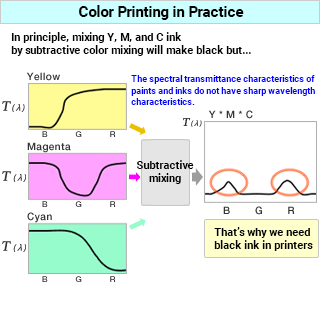Theory of Light and Color

16. Color Mixing (Part 2)
Additive and Subtractive Color Mixing, an Example
We have explained the principles of additive and subtractive color mixing through their three primary colors (additive color mixing: B, G, R, subtractive color mixing: Y, M, C). In reality, these principles are not limited to mixing the three primary colors but can be applied to any colors. White LEDs are an example of additive color mixing, and color photography (silver halide photography) and color printing are examples of subtractive color mixing.
Example of Additive Color Mixing
<Principle of White LED>
LEDs are close to a monochromatic light source since the spectral distribution is concentrated in a narrow wavelength range. There are several ways to realize white LEDs, which have energy distributed over the entire visible range:
(a) Multi-Chip LED Method
Multiple chips mounted in the same LED package emit colored light and create white through additive color mixing.
(Ⅰ) Complementary color method
LED chips of two complementary colors such as blue and yellow are combined to produce white.
(Ⅱ) Three primary colors RGB method
LED chips of the primary colors of additive color mixing, blue (B), green (G), and red (R), are used together to generate white.
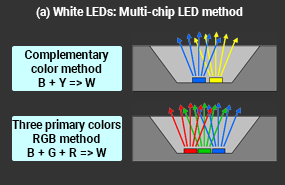
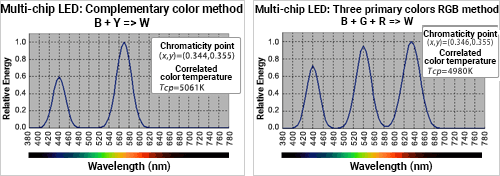
(b) Single Chip LED Method (Fluorescence Excitation Method)
It creates a white color by irradiating blue or shorter wavelengths (violet or near-ultraviolet) on fluorescent material so it fluoresces at a longer wavelength. The lights combine (additive color mixing) to create a white color.
(Ⅰ) Complementary color fluorescence method (blue excitation light + yellow fluorescence)
Irradiating blue light on fluorescent material generates yellow fluorescence, and the additive color mixing of blue and yellow creates white light (B + Y = W). This method has been the mainstay of white LEDs because of its high energy conversion efficiency. The excitation light from the blue LED generates yellow fluorescence using a phosphor called yttrium aluminum garnet (Yttrium Aluminum Garnet), which is why it is commonly referred to as the Blue-YAG type.
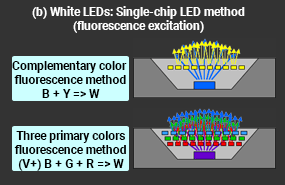
(Ⅱ) Three primary colors fluorescence method (violet or near-ultraviolet excitation light + BGR fluorescence)
The excitation light comes from near-ultraviolet or violet LEDs, which are covered by three types of phosphors that generate B, G, and R fluorescence.
Our natural light LED uses a purple LED with a wavelength of 405 nm as an excitation light source and a phosphor that generates three types of fluorescence (B, G, R) to achieve a continuous spectrum over the entire visible range. The spectral distribution is not as uneven as other white LED types, resulting in high color rendering.
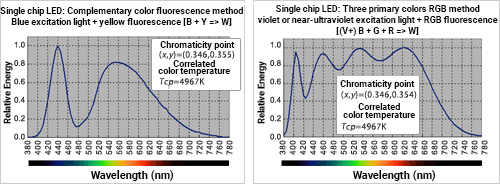
Application Example of Subtractive Color Mixing: Color Photography (Silver Halide Film)
<Principle of Negative Film>
Color negative film uses three layers of photosensitive materials for blue, green, and red applied on the film base. When used to take a picture, the three-layer film is exposed to light passing through the lens of the camera. The color negative (negative image) is obtained after developing the film.
As shown in the figure, the photosensitive characteristics of color negative film are such that the B, G, and R photosensitive layers have sensitivity in the short, medium, and long wavelength regions of the visible spectrum, respectively. Each photosensitive layer develops in its complementary color. Specifically, the blue photosensitive layer develops yellow, the green photosensitive layer develops magenta, and the red photosensitive layer develops cyan. The exposure on each layer depends on the spectral distribution of the light and the photosensitivity of each layer.
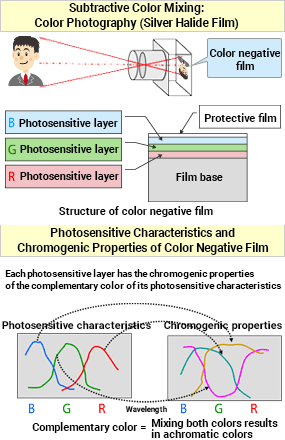
The color negative film is then illuminated with white light, and the negative image transfers onto photographic paper (positive image). Similar to color negative film, photographic paper also has B, G, and R photosensitive layers coated on the surface of its base material. By developing the photographic paper, each photosensitive layer develops its complementary color, that is, a positive image can be obtained by developing Y, M, and C.
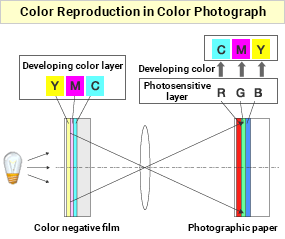
For example, a lemon reflects mostly middle- and long-wavelengths in the visible range (Y=G+R), so the photosensitive layers of G and R on the film are strongly exposed to light, while B receives little exposure. When developed, the layers of G and R respectively turn magenta (M) and cyan (C), and the B layer turns transparent.
By irradiating white light on the color negative film in the printing process, short wavelengths (B) transmitted through the M and C filters pass through the negative film and form an image on the photographic paper. Since only the B layer is strongly exposed to light, it turns yellow (Y), which is the complementary color of B. As a result, the yellow of the lemon is reproduced in the positive image.
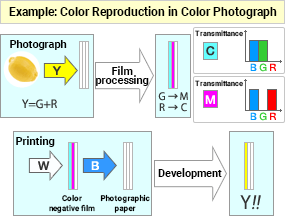
For subtractive color mixing in color printing, K (black) is also used in addition to the three primary colors of colorants Y, M, and C. Actual inks do not have ideal transmittance of 0% or 100% for each wavelength range. Therefore, even in subtractive color mixing of the three primary pigments, there are inconsistencies in the overall spectral transmittance as shown in the figure. The color is not pure black and retains a slight tinge of color. A separate black ink (K for "key") is needed, which has a low and even transmittance over the entire wavelength range.
